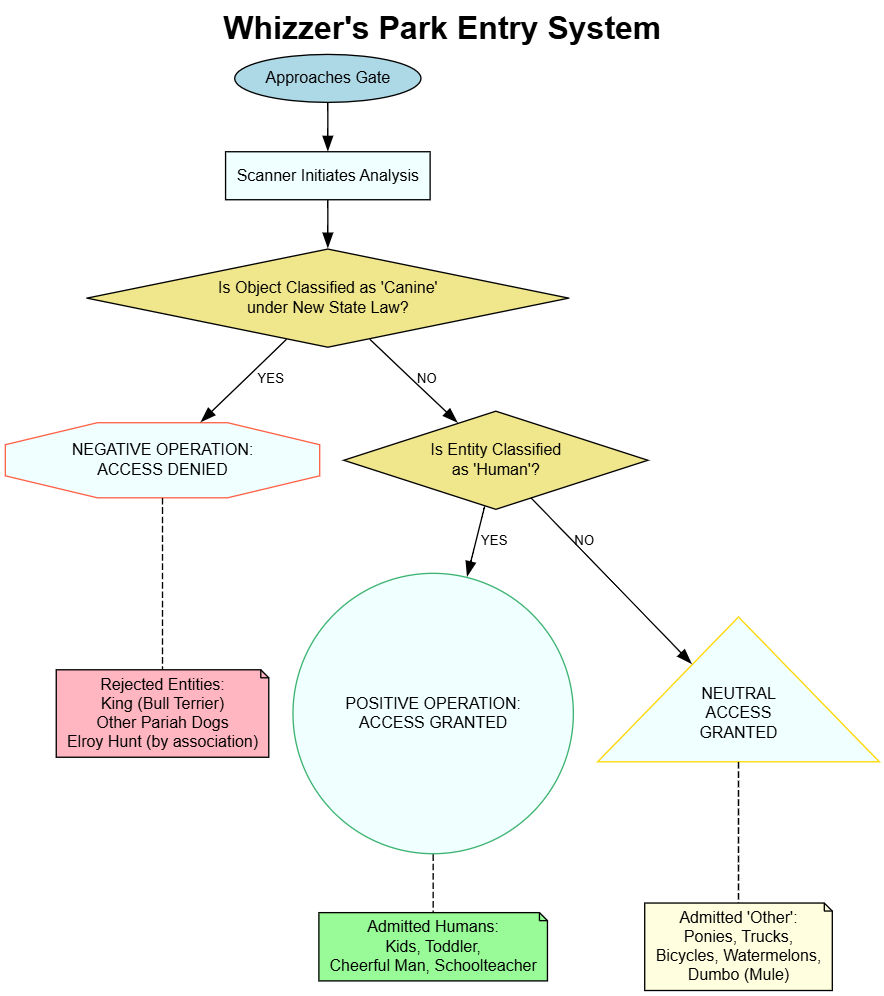"The Doggone Highly Scientific Door" (1974/1984)
- Jon Nelson
- Sep 10, 2025
- 4 min read
Updated: Sep 11, 2025

“You go on home, King!” one of the kids called to the dog from inside the park. “They won't let dogs inside the park this year. Or stay with Mr. Hunt if you want to."
A short post today on Lafferty’s “The Doggone Highly Scientific Door.”
Lafferty makes most of us laugh. This is a story that makes me laugh more than once. It follows Elroy Hunt, a perpetually forty-nine-year-old carnival enthusiast who sees himself as a perpetual kid. One day, Elroy is barred from entering Whizzer's Amusement Park. The park’s new, highly scientific doors open for everyone else, from children and adults to trucks and horses. They slam shut at Elroy.
After failing to get in through several entrances, Elroy teams up with a bull terrier named King, who is also denied entry. He grows increasingly frustrated. Lafferty dials up the slapstick. The reader meets some unimaginative people who have authoritarian streaks. The park staff insists the doors are infallible and designed to keep out dogs. And the story ends memorably.
That does nothing to capture the energy or comic timing. The action takes place in a single setting and plays out like a vaudeville routine or a scene from early slapstick. When the Lafferty family left Neola, Iowa, for Oklahoma, Lafferty was four. They settled in Perry, the birthplace of Buster Keaton, and the story plays like a Keaton set piece.
So the bull terrier named King decided to stay with Elroy Hunt and hook his fortunes to Elroy's. They had been acquaintances but not close friends. Now they looked at each other. They plotted a small plot together in a lightning meeting of minds. Both rushed at the door with absolute shouting-and-barking confidence that it would swing open for them if only they had faith. And both cracked themselves jarringly on the closed adamant door (it was really made out of wood and chrome and glass). One little kid (hardly more than a toddler) approached the door, and it swung wide open. The little kid padded in, and Elroy and King (rushing for the momentary gap) hit the closing door so hard that they both bounced. Frustrated, they both went over and sat on the bench that was only three long steps from the door. King licked his bruised foreshoulder. Elroy licked the heel of his hand that was bloodied and scraped.
As for the highly scientific door itself, such doors have mattered in science fiction at least since H. G. Wells’s When the Sleeper Wakes (1899). Sliding automatic doors entered American life in 1954, when Dee Horton and Lew Hewitt invented them using a mat actuator. By the time Star Trek premiered in 1966, they were a reality. In the 1960s, the invention of the Gunn diode made motion detection practical: its compact microwave oscillators allowed doors to sense movement. The Gunn diode, named after physicist J. B. Gunn, is a semiconductor device that exploits a negative resistance effect to generate high-frequency microwave oscillations, making it useful in radar and motion-sensing applications. By the 1970s, microwave-based sensors were in widespread use. These systems emitted continuous microwave signals that shifted in frequency when reflected by a moving object, triggering the mechanism.
Lafferty finished the story in May 1974, during the heyday of the Gunn diode, but also at a time when he was thinking about Charles Fort, with Forteanism being an element of "Oh, Whatta You Do When the Well Runs Dry" (October 1974) and "Bequest of Wings" (January 1975). I’d place “The Doggone Highly Scientific Door” among Lafferty’s Fortean tales for the way it critiques scientific classification. Like Fort’s own work, it satirizes classification systems gone haywire, taking aim at the “damned data” science doesn’t know what to do with. In this case, the damned data is Elroy Hunt.
One of the finest things in the story is the behavioral comedy of Elroy and King—it would make an excellent series of illustrations.
It also feels very much alive, and it reminds me of Henri Bergson (1859–1941). In Laughter: An Essay on the Meaning of the Comic (1900), Bergson wrote that comedy arises when the mechanical appears in the midst of the living. We laugh when life takes on the stiffness of a machine, when spontaneity gives way to habit or automatic behavior. Laughter is corrective. It steers us back toward vitality, freedom, and creativity. It reminds us what it means to be alive: to stop acting like machines. If "The Doggone Highly Scientific Door" has a didactic edge, it is something like this.
Along the way, Lafferty also slips in some great puns. The ending loops back to the beginning, with Elroy’s simple love of candy, and through the middle, where Lafferty writes,
“Hey, King, I won you a dog bowl,” the boy Curtis shrilled. “I won it throwing lopsided baseballs at wooden milk bottles. I sure am good at hitting those bottles.” He gave the fine bowl to King. The bowl had KING written on it in red letters, and King’s day was made, in spite of the humiliation of being excluded from the amusement park.
Of course, Elroy is just Spanish for the king.





